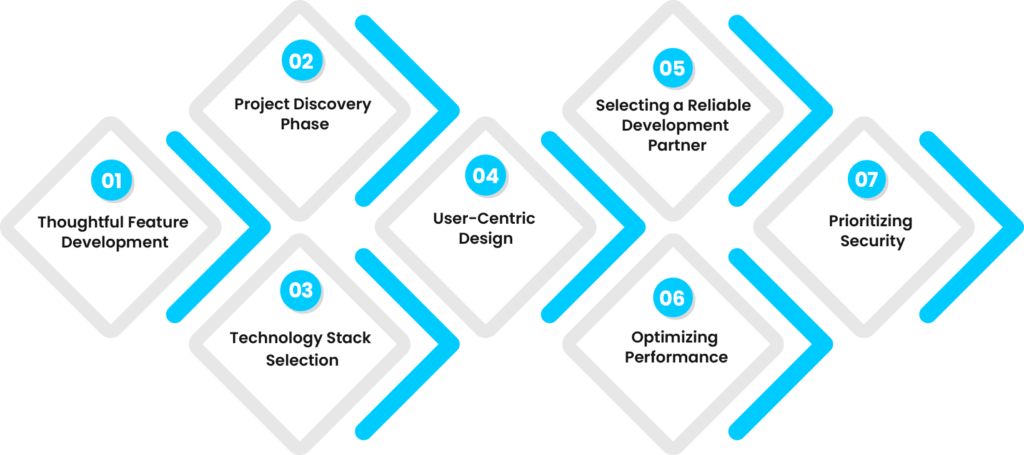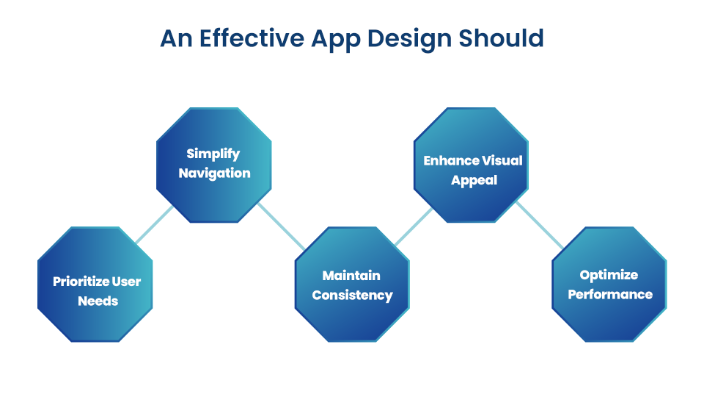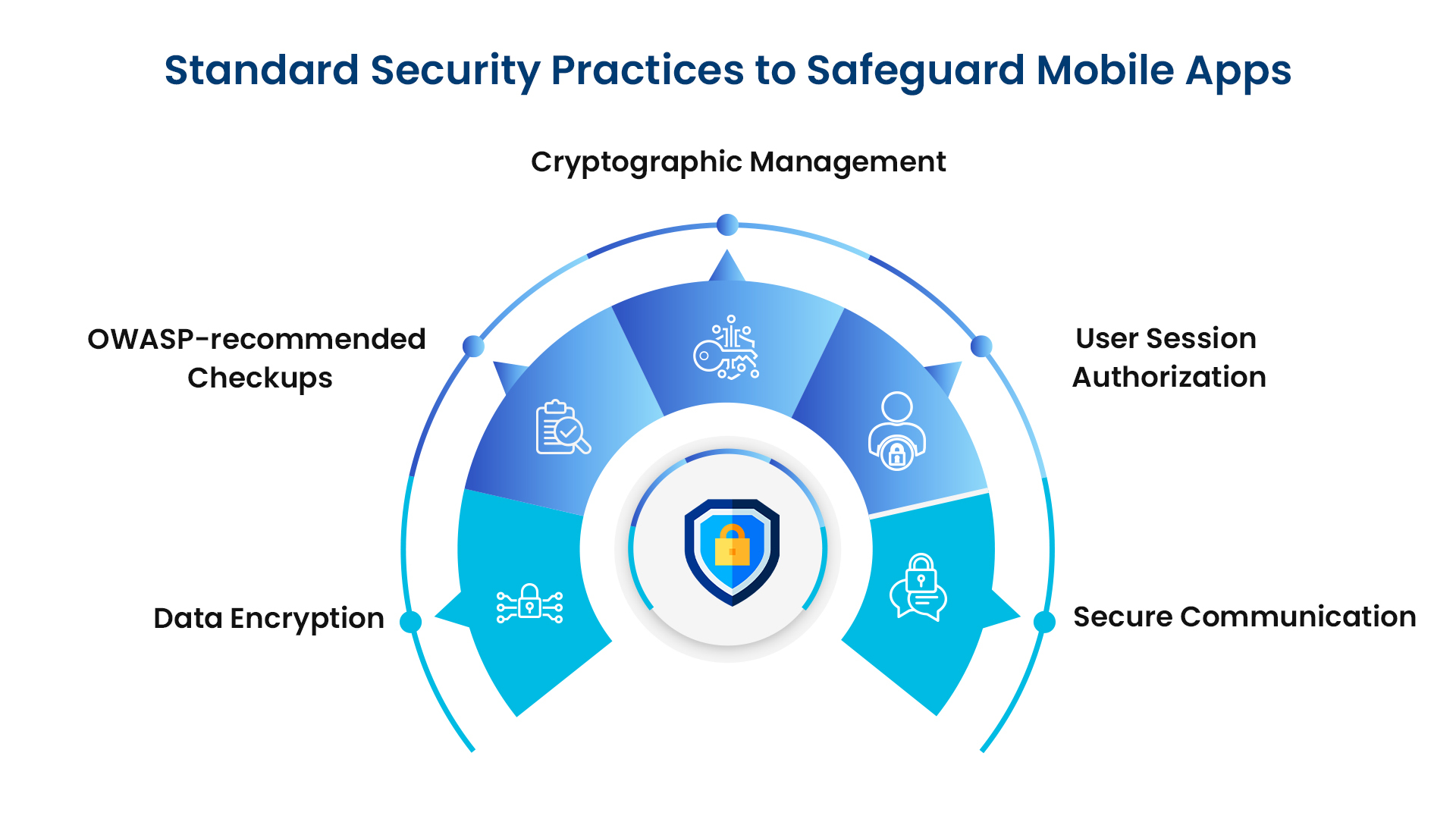Smartphone users value mobile apps for their scalability, reliability, and robustness. This is why many new apps struggle to gain traction in the crowded Google and Apple marketplaces, while others soar to success. And when an app becomes popular, it can be a lucrative asset for its creators.
If you’re contemplating launching a mobile app and seeking guidance on how to ensure its success, this blog post is for you!
We’ll explore some essential tips for app development that can help you create user-friendly apps and thrive in today’s competitive digital market.
Key Steps to Create a Successful App

In the initial stages of app development, it’s crucial to focus on Thoughtful Feature Development. By prioritizing essential features, you optimize resources and enhance user satisfaction and loyalty, thus increasing your app’s chances of success.
Moving into the Project Discovery Phase, thorough planning becomes paramount. This phase involves comprehensive data collection, analysis, prototyping, and development planning. The goal is to ensure that your app aligns with user needs and expectations right from the start.
When it comes to Technology Stack Selection, it’s essential to choose wisely. Whether opting for native or cross-platform development, selecting the right technology stack is crucial. Consider the app’s complexity and requirements for optimal performance and cost-effectiveness.
User-Centric Design is another critical aspect of app development. Design your app with the user in mind, focusing on creating a visually appealing, intuitive, and fast-loading experience. This approach maximizes user engagement and satisfaction, contributing to the app’s success.
Selecting a Reliable Development Partner is key to bringing your app vision to life. Partner with a reputable development company that offers technical expertise, efficient project management, clear communication, and ongoing support tailored to your app’s specific needs.
Once your app is developed, Optimizing Performance is essential to ensure its success. Comprehensive testing, speed optimization, performance monitoring, analytics implementation, and regular updates are necessary to maintain flawless app performance and user satisfaction.
Finally, Prioritizing Security is non-negotiable in today’s digital landscape. Protect user data and build trust by implementing robust security measures such as encryption, authentication, authorization, secure coding practices, regular updates, and vulnerability testing. This safeguards user privacy and enhances the overall integrity of your app.
What contributes to the success of a mobile app?
Examining popular apps like TikTok, Instagram, WhatsApp, CapCut, and Spotify reveals common traits that set them apart. These key features can elevate any application to popularity.
Critical factors for mobile app success:
- Intuitive and Attractive Design
- Thoughtful User Experience (UX)
- Efficient Problem Solving
- Reliability and Speed
- Data Security
- Accessible Help Center
- Retention Features
- Seamless Payment Processing
Six Crucial Tips for Successful App Development
- Commence with a Refined Feature Set
A meticulously crafted feature list is pivotal for a triumphant app launch. It ensures that your app addresses users’ needs without surpassing the budget allocated for less essential features.
To create a flourishing app, initiating the mobile app development journey with a project discovery phase is imperative. This phase aids in sculpting the ideal feature list for your upcoming app, thereby amplifying your prospects for success.
The discovery phase encompasses various essential tasks, including data collection, thorough analysis, feature list formulation, prioritization, prototyping, and development planning. As such, it stands as a critical step in bespoke mobile app development.
Key undertakings that contribute to crafting the right feature list for a prosperous app include:
‒Market Research: Delving into the needs of end-users.
‒Competitor Analysis: Identifying features, unique selling points (USPs), and marketing strategies to rival existing apps and seize the market.
‒Road Mapping: Providing an initial estimate of the time and resources required to complete the project.
‒Industry Trends Analysis: Determining elements that can distinguish your app and ensure its relevance in both the short and long term.
In essence, a well-defined feature list furnishes you with a winning product vision while mitigating the risks of product failure.
- Select the Optimal Technology Stack
Selecting the appropriate technology stack for your app is pivotal to its success. Presently, two primary app development approaches are prevalent.
Native App Development involves customizing apps for each platform, delivering exceptional performance and user experience tailored to specific operating systems.
On the other hand, Cross-Platform App Development achieves cost-effectiveness and time efficiency by leveraging the advantages of native development while enabling code reuse across multiple platforms.
If you’re not well-versed in technology, it’s advisable to seek guidance from an experienced app development team to determine which technology stack aligns best with your project’s requirements.
- Craft a User-Friendly App Design
As mentioned previously, UX and UI design play pivotal roles in determining an app’s popularity among users. Transform this process into a goal-oriented endeavor, tailoring every aspect to meet your users’ needs and expectations.
A well-designed app featuring an intuitive user interface and user-centric features significantly enhances the user experience, fostering increased engagement and retention. Incorporating visually appealing design elements further enhances the app’s allure, driving user downloads and positive reviews, ultimately contributing to its success.

Key Principles for Effective App Design:
‒Design with your target audience in mind: Understand their preferences, pain points, and expectations to tailor the app accordingly.
‒Keep it simple: Foster a user-friendly design that is easy to navigate and intuitive, minimizing complexity.
‒Adhere to design guidelines: Follow platform-specific design standards, such as Apple’s Human Interface Guidelines and Google’s Material Design Guidelines, to ensure consistency and alignment with platform norms.
‒Conduct user testing: Solicit feedback from real users to validate the design’s effectiveness and make necessary refinements based on their insights.
By adhering to these principles, you can ensure that your app design resonates with users, driving engagement, satisfaction, and ultimately, success.
- Secure a Trustworthy App Development Team
When it comes to developing an app, you’ve got a few options: you can put together your own team, hire freelancers, or work with a development agency. Each choice has its upsides and downsides, so it’s important to choose what works best for you based on your needs.
Selecting a dependable and experienced development team can significantly impact the success of your app. A reputable company brings expertise in coding languages, software development methodologies, and app design to the table. This expertise ensures the creation of a high-quality, stable, and secure app. Additionally, their experience across various industries and platforms equips them to anticipate challenges, avoid common pitfalls, and implement best practices effectively.
Effective project management is another critical factor. Esteemed development companies follow well-structured project management processes to ensure timely completion while meeting desired quality standards. They maintain transparent communication with clients, providing regular updates on project progress and actively seeking feedback throughout the development journey.
Moreover, post-launch support and maintenance are integral aspects of a reliable development company. They offer ongoing assistance to ensure the app remains up-to-date, secure, and fully functional. This support enhances the user experience and contributes to the long-term success of the app.
- Ensure Seamless App Performance
Guaranteeing flawless app performance is paramount for the development of a successful mobile app and ensuring a positive user experience. Here are some strategies to achieve this objective:
‒Comprehensive Testing: Thoroughly test your app to identify and fix any bugs or glitches. Test across various devices, operating systems, and networks to ensure compatibility and functionality.
‒Speed and Performance Optimization: Optimize your app’s speed and performance by reducing loading times, minimizing data usage, and optimizing resource consumption. Techniques like caching and data compression can help improve performance.
‒Implementation of Analytics: Use analytics tools to monitor app performance metrics such as crashes, errors, and user engagement. Analyzing this data can help you identify issues and improve the app over time.
‒Regular Updates: Keep your app updated with regular releases to address bugs, incorporate user feedback, and introduce new features. This not only improves performance but also keeps users engaged and satisfied.
‒Performance Monitoring: Utilize performance monitoring tools to regularly track your app’s performance. This proactive approach helps identify and resolve issues before they become major problems.
By adhering to these practices, you can ensure that your app delivers a seamless and optimized user experience, thereby increasing its chances of success in the competitive app market.
- Prioritize Security in App Development
In the evolving landscape of mobile app development, security remains a paramount concern. As we delve into 2024, it’s crucial to address prevalent security threats to safeguard user data and ensure the integrity of mobile and web applications.
Here are some common security threats to watch out for:
‒Man-in-the-Middle Attack (MitM): This occurs when hackers intercept communication between a user and a system server, compromising security and gaining access to sensitive data.
‒Advanced Persistent Threats (APT): Attackers exploit vulnerabilities to gain unauthorized access to system networks or hardware, stealthily exfiltrating sensitive data without being detected.
‒Password Attacks: Hackers use various techniques, including brute force attacks and social engineering, to obtain user passwords and access system databases illicitly.
‒Social Engineering Attacks: Manipulative tactics are employed to deceive users into divulging confidential information, granting hackers unauthorized access to sensitive data.
Neglecting security measures not only endangers user identities but also undermines the credibility of the entire app ecosystem. Hence, implementing robust security measures is vital for the success and trustworthiness of any app.

Securing mobile apps against potential threats requires expertise and diligence. Entrusting security considerations to an experienced and reliable app development team is essential to mitigate risks effectively.
Make sure your development team diligently addresses security threats, safeguarding users’ confidential data, and upholding the trust and integrity of your app ecosystem. Let specialists handle security concerns to prevent unauthorized access and protect user privacy effectively.
Conclusion
In short, creating a successful mobile app in 2024 requires careful planning, user-focused design, and attention to detail. Prioritize user satisfaction, simplicity, and excellence throughout the development process. By following these principles and collaborating with trusted partners, you can bring your app to life and thrive in today’s competitive digital market.





